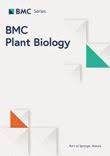Ver ítem
- xmlui.general.dspace_homeCentros Regionales y EEAsCentro Regional Mendoza - San JuanEEA MendozaArtículos científicosxmlui.ArtifactBrowser.ItemViewer.trail
- Inicio
- Centros Regionales y EEAs
- Centro Regional Mendoza - San Juan
- EEA Mendoza
- Artículos científicos
- Ver ítem
Modulation of flavonoid biosynthetic pathway genes and anthocyanins due to virus infection in grapevine (Vitis viniferaL.) leaves
Resumen
Background: Symptoms of grapevine leafroll disease (GLRD) in red-fruited wine grape (Vitis vinifera L.) cultivars consist of green veins and red and reddish-purple discoloration of inter-veinal areas of leaves. The reddish-purple color of symptomatic leaves may be due to the accumulation of anthocyanins and could reflect an up-regulation of genes involved in their biosynthesis.
Results: We examined six putative constitutively expressed genes, Ubiquitin,
[ver mas...]
Background: Symptoms of grapevine leafroll disease (GLRD) in red-fruited wine grape (Vitis vinifera L.) cultivars consist of green veins and red and reddish-purple discoloration of inter-veinal areas of leaves. The reddish-purple color of symptomatic leaves may be due to the accumulation of anthocyanins and could reflect an up-regulation of genes involved in their biosynthesis.
Results: We examined six putative constitutively expressed genes, Ubiquitin, Actin, GAPDH, EF1-a, SAND and NAD5, for their potential as references for normalization of gene expression in reverse transcription-quantitative real-time polymerase chain reaction (RT-qPCR). Using the geNorm program, a combination of two genes (Actin and NAD5) was identified as the stable set of reference genes for normalization of gene expression data obtained from grapevine leaves. By using gene-specific RT-qPCR in combination with a reliable normalization factor, we compared relative expression of the flavonoid biosynthetic pathway genes between leaves infected with Grapevine leafroll-associated virus 3 (GLRaV-3) and exhibiting GLRD symptoms and virus-free green leaves obtained from a red-fruited wine grape cultivar (cv. Merlot). The expression levels of these different genes ranged from two- to fifty-fold increase in virus-infected leaves. Among them, CHS3, F3'5'H, F3H1, LDOX, LAR1 and MybA1 showed greater than 10-fold increase suggesting that they were expressed at significantly higher levels in virus-infected symptomatic leaves. HPLC profiling of anthocyanins extracted from leaves indicated the presence of cyanidin-3-glucoside and malvidin-3-glucoside only in virus-infected symptomatic leaves. The results also showed 24% higher levels of flavonols in virus-infected symptomatic leaves than in virus-free green leaves, with quercetin followed by myricetin being the predominant compounds. Proanthocyanidins, estimated as total tannins by protein precipitation method, were 36% higher in virus-infected symptomatic leaves when compared to virus-free green leaves.
Conclusions: The results, the first example to our knowledge, showed that modulation of the flavonoid biosynthetic pathway occurred in GLRaV-3-infected leaves of a red-fruited wine grape cultivar (cv. Merlot) leading to de novo synthesis of two classes of anthocyanins. These anthocyanins have contributed to the expression of reddish-purple color of virus-infected grapevine leaves exhibiting GLRD symptoms.
[Cerrar]

Autor
Gutha, Linga R.;
Casassa, Luis Federico;
Harbertson, James F.;
Naidu, Rayapati A.;
Fuente
BMC Plant Biology 10 : article number: 187 (2010)
Fecha
2010-08
Editorial
BMC
ISSN
1471-2229
Formato
pdf
Tipo de documento
artículo
Palabras Claves
Derechos de acceso
Abierto
 Excepto donde se diga explicitamente, este item se publica bajo la siguiente descripción: Creative Commons Attribution-NonCommercial-ShareAlike 2.5 Unported (CC BY-NC-SA 2.5)
Excepto donde se diga explicitamente, este item se publica bajo la siguiente descripción: Creative Commons Attribution-NonCommercial-ShareAlike 2.5 Unported (CC BY-NC-SA 2.5)


